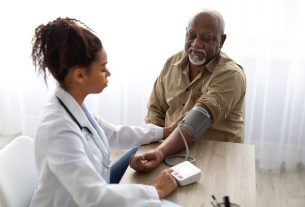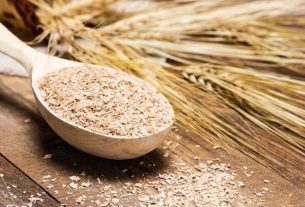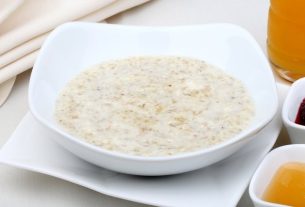Dermatitis is an inflammation of the skin that causes symptoms such as redness, itching, peeling and the formation of small blisters filled with transparent liquid, which can appear in different parts of the body and at any age.
Also known as eczema, dermatitis can be caused by contact with substances or tissues that cause allergies, side effects of some medications, poor blood circulation or very dry skin, for example.
The treatment of dermatitis must be carried out by a general practitioner or dermatologist and varies depending on the type of condition, and the use of creams, ointments, anti-allergy medicines, corticosteroids or shampoos may be recommended.
Types and symptoms of dermatitis
Depending on the type of condition, dermatitis can present different symptoms:
1. Atopic dermatitis
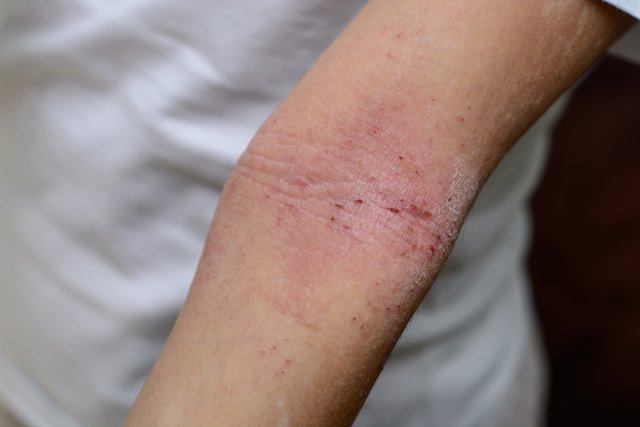
Atopic dermatitis is more common in babies and children up to 5 years of age, and is characterized by red and/or grayish lesions, which cause itching or peeling and which appear mainly behind the knees, neck, groin, elbows and folds of the arms. See more about atopic dermatitis.
The causes of this type of dermatitis are not yet known, but it is normally seen in people with a family history of this condition or who have asthma or allergic rhinitis.
2. Contact dermatitis
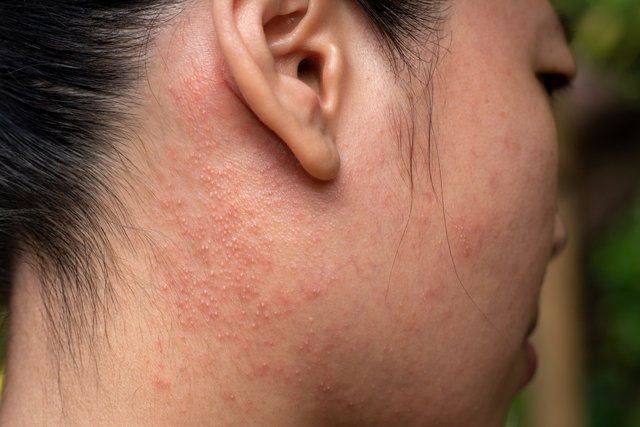
Contact dermatitis, which includes allergic contact dermatitis and irritant contact dermatitis, causes blisters, itching and redness anywhere on the body, such as the ear, face, scalp, eyelids, neck, armpits and hands. Learn how to identify contact dermatitis.
Contact dermatitis can be caused by contact with irritating substances or objects, such as nickel, cosmetics, perfumes, dust, soaps, detergents or latex, for example.
3. Seborrheic dermatitis
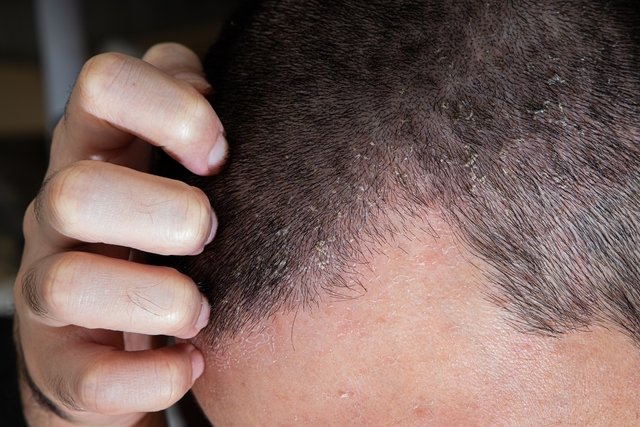
Seborrheic dermatitis especially affects the scalp and oily areas of the skin, such as the sides of the nose, face, ears, beard, eyelids and chest, causing redness, spots and peeling of the skin. Check out all the symptoms of seborrheic dermatitis.
It is believed that this type of dermatitis is related to the Malassezia fungus, which is present on the skin, but can grow very large in some people; family history; stress; and the presence of other skin diseases, such as rosacea, psoriasis and acne.
4. Perioral dermatitis
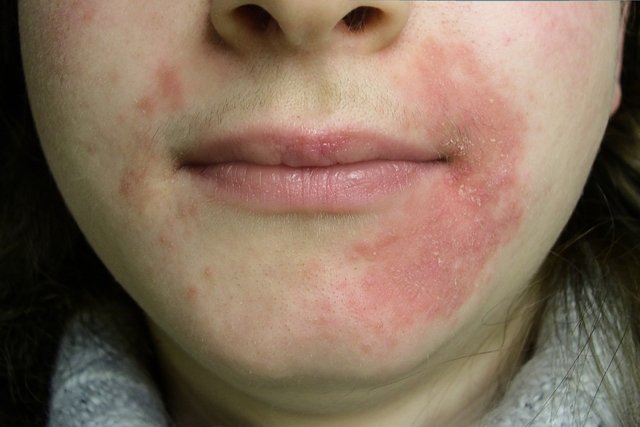
This type of dermatitis causes the appearance of reddish balls, filled with pus, around the mouth, itching and a burning sensation. Although it is most common around the mouth, perioral dermatitis can also affect the eyelids, cheeks, around the eyes or nose. See more about perioral dermatitis.
Perioral dermatitis is more common in women between the ages of 20 and 45 and the cause of this condition is still unknown. However, it is believed to be associated with situations such as the use of creams and sprays containing corticosteroids and changes in the skin flora.
5. Dermatite ocre
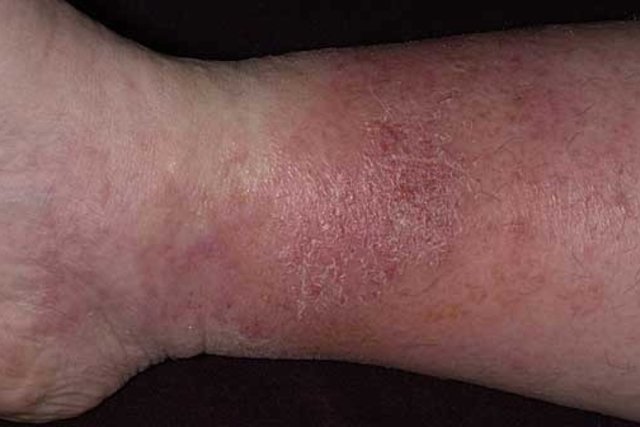
Ocher dermatitis, or stasis dermatitis, generally occurs in people with venous insufficiency, that is, when blood has difficulty returning to the heart, accumulating in the legs. Discover all the causes of ocher dermatitis.
The main symptoms of this dermatitis are swelling and a purplish or brown color on the legs and ankles, itching and wounds with pus and crusts.
6. Herpetiform dermatitis
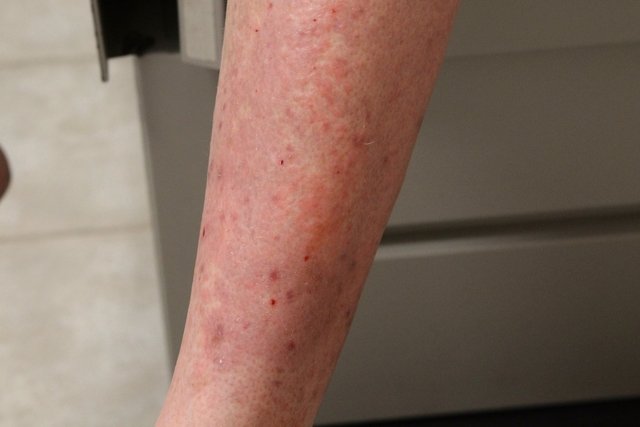
Dermatitis herpetiformis is an autoimmune disease caused by gluten intolerance and causes symptoms such as small red blisters that burn and itch. Learn more about dermatitis herpetiformis.
This type of dermatitis most often affects the scalp, shoulders, buttocks, elbows and knees.
7. Diaper dermatitis
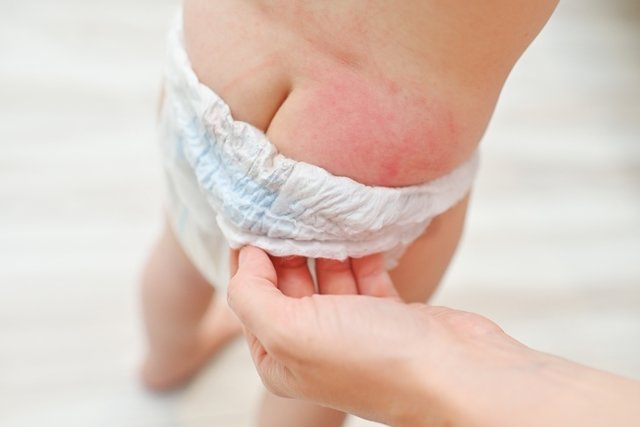
Also known as diaper rash, diaper dermatitis is characterized by the presence of bumps, redness and scaling on the baby’s groin, thighs, scrotum or buttocks.
This type of dermatitis can be caused by humidity, allergies, friction of the baby’s skin with the diaper or long periods of contact with feces or urine, for example.
8. Exfoliative dermatitis
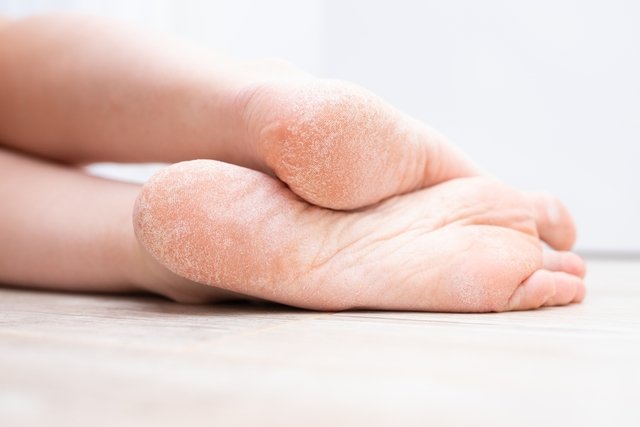
Exfoliative dermatitis is a serious inflammation of the skin that causes peeling, red and shiny spots on the chest, arms, feet or legs, hair loss in the affected regions, brittle nails and fever above 38ºC. Learn about other symptoms of exfoliative dermatitis.
Generally this type of dermatitis is caused by other skin problems, such as psoriasis or eczema, but it can also be caused by excessive use of medicines such as antibiotics, antiepileptics, lithium and allopurinol, for example.
9. Dermatite numular
Sensitive content
This image may contain content that is uncomfortable for some people.
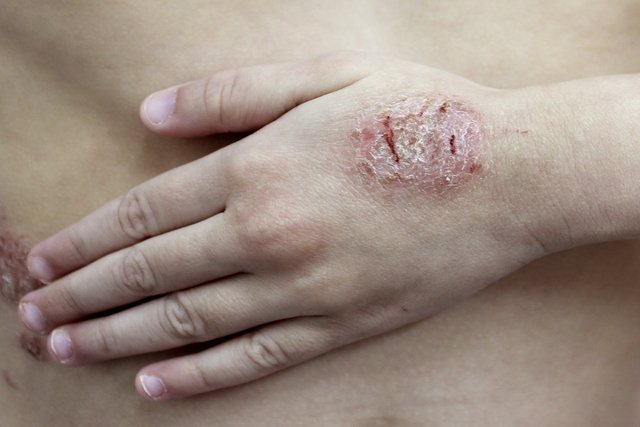
This type of dermatitis consists of the appearance of rounded red, pink or brown spots, which burn or itch and evolve into blisters and crusts. Nummular dermatitis usually appears on the arms, legs, hands or trunk.
Although the cause of this type of dermatitis is not yet known, it is believed to be caused by factors such as allergies, bacterial infections, extremely dry skin, hot baths, use of soaps and other products that dry out the skin. See more about nummular dermatitis.
10. Moth dermatitis or Hylesia dermatitis
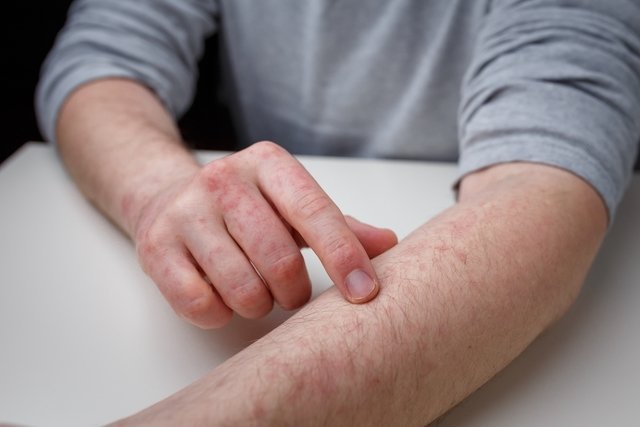
Moth dermatitis is caused by the Hylesia moth, which is nocturnal and, during flight, releases bristles that can penetrate deeply into the skin and lead to intense itching and local redness, especially at night.
Online symptom test
To find out the chances of having dermatitis, please select the symptoms you present:
This test is a tool that serves as a means of guidance only. Therefore, it is not intended to provide a diagnosis and does not replace consultation with a dermatologist or general practitioner.
How the diagnosis is made
The diagnosis of dermatitis must be made by a general practitioner or dermatologist, through evaluation of the skin and the person’s family health history.
To confirm the diagnosis, the doctor may also request some tests and exams such as skin biopsy, allergy skin test and blood test to evaluate thyroid functions and the level of IgE, which is a protein that, in high concentrations, is related to allergies.
Taking care of your health has never been easier!
Causes of dermatitis
The main causes of dermatitis are:
- Allergy to pollen, cosmetics, latex or insect bites;
- Side effects of medicines;
- Exposure to cigarette smoke or pollution;
- Hot baths;
- Contact with synthetic fabrics;
- Cleaning products, such as detergent and disinfectants;
- Depression;
- Climate change;
- Gluten intolerance;
- Use of soaps, shampoo and perfumes;
- Genetic factors;
- Hair products containing formaldehyde or paraphenylenediamine (PPD).
In addition, dermatitis can also be caused by poor blood circulation or the use of creams, ointments and sprays containing antibiotics or corticosteroids.
What is the treatment like?
The treatment of dermatitis must be carried out under the guidance of a general practitioner, or dermatologist, and varies depending on the cause of this condition, including rest, diet or the use of medicines, creams and shampoos.
1. Ointments or creams
Ointments and creams with corticosteroids or antihistamines, such as clobetasol propionate or triamcinolone or dexamethasone, may be indicated to reduce skin inflammation and alleviate the symptoms of atopic dermatitis, contact dermatitis, seborrheic dermatitis, dermatitis herpetiformis and exfoliative dermatitis.
In addition, the use of emollient or urea creams may also be indicated to help treat atopic dermatitis, contact dermatitis and exfoliative dermatitis.
For the treatment of diaper dermatitis, the doctor may prescribe the use of zinc ointments in the affected region to protect the baby’s skin, facilitating healing.
2. Shampoos
Shampoos containing corticosteroids, such as hydrocortisone, fluocinolone, clobetasol or desonide, are generally indicated to alleviate the symptoms of seborrheic dermatitis. See other shampoos for seborrheic dermatitis.
3. Medicines
The use of corticosteroids and oral antihistamines may be prescribed by your doctor to reduce itching and inflammation in atopic and contact dermatitis. The treatment of exfoliative dermatitis must be done with the administration of corticosteroids directly into the vein, in a hospital environment.
The doctor may also prescribe medicines containing hesperidin and diosmin to treat the symptoms caused by venous insufficiency in ocher dermatitis.
In addition, the use of oral antibiotics may also be indicated for the treatment of stasis dermatitis, dermatitis herpetiformis and perioral dermatitis.
4. Diet
To treat dermatitis herpetiformis, you must follow a low-gluten diet, excluding wheat, barley and oats from your diet. To treat atopic dermatitis, it is recommended to avoid foods that can cause allergies, such as shrimp, peanuts or milk.
5. Rest
Rest is recommended in the case of ocher dermatitis, and it is also recommended that the person wear elastic stockings and keep their legs elevated to avoid the accumulation of blood.
Other precautions during treatment
Some precautions that are important during the treatment of dermatitis are:
- Avoid contact with materials or substances that cause skin allergies;
- Do not take a bath with very hot water;
- Avoid scratching the affected area;
- Use neutral soaps and detergents;
- Avoid using perfumes.
It is also important to avoid drinking alcoholic beverages and foods rich in fat and sugar, such as sausages, sausages, biscuits or ham, for example. This is because these foods promote inflammation in the skin, making it difficult for dermatitis to heal.

Sign up for our newsletter and stay up to date with exclusive news
that can transform your routine!
Warning: Undefined array key "title" in /home/storelat/public_html/wp-content/plugins/link-whisper-premium/templates/frontend/related-posts.php on line 12
Warning: Undefined array key "title_tag" in /home/storelat/public_html/wp-content/plugins/link-whisper-premium/templates/frontend/related-posts.php on line 13

